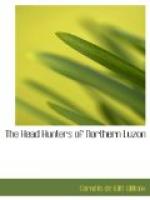[40] De La Gironiere, in his “Aventures d’un Gentilhomme Breton aux Iles Philippines,” describes (Chapter V.) a feast, at which he had, while on a visit to the Tinguianes, to drink human brains mixed with basi. Whatever De La Gironiere says must be received with considerable caution; but Pickering, a prosaic and matter-of-fact Britisher, speaking of the Formosan savages, says that “they mixed the brains of their enemies with wine.” ("Pioneering in Formosa,” p. 153).
[41] For example, this year (1912) more people “came in” to meet Mr. Worcester then ever before. In Bontok every valley of the sub-province was represented, and there was a time when representatives of all the villages danced together on the plaza, an event of importance in the history of these people as marking the passing of old feuds and a determination to live at piece with one another. A moving picture machine was taken along in a four-wheeled wagon (showing incidentally that the main trails have become roads since 1910), and created both enthusiasm and alarm: enthusiasm when some familiar scene with known living persons was thrown upon the screen, and alarm when a railway train, for example, was shown advancing upon the spectators, causing many of them to flee for safety to the neighboring hills and woods.
[42] For an account of what this Government monopoly really meant, see Jagor, “Travels,” etc., p. 324. A Spaniard of my acquaintance told me that if a native’s attention to his crop did not please the inspectors, they would cause him to be publicly flogged on Sunday before the church after mass; and if this course brought no amendment, they would then cut his stand down. Jagor, who travelled in the Philippines as long ago as 1859-60, could see no future for them save under American control, and he predicted that this control would come, an astonishing prophecy. “In proportion as the navigation of the west coast of America extends the influence of the American element over the South Sea, the captivating, magic power which the great Republic exercises over the Spanish colonies will not fail to make itself felt also in the Philippines. The Americans are evidently destined to bring to a full development the germs originated by the Spaniards.” ("Travels in the Philippines,” p. 369.) Jagor’s work, it may be remarked, will always remain an authority on the Philippines.
[43] The cable and popular name of the “Compania General de Tabacos de Filipinas”; it owns plantations up the Grande in Isabela Province.
[44] So do the aborigines of Formosa. “These aborigines of the hills live in villages. Their houses are built, of stone, roofed with slate, and have a remarkably clean, home-like appearance.” (Pickering, “Pioneering in Formosa,” p. 69.)
[45] The word “Filipino” is taken to mean the civilized, Christianized inhabitant of Malay origin of the Philippine Islands. As such, it is convenient and useful. It should be recollected, however, that there is no such thing as a Filipino people. There are Tagalogs, Visayans, Bicols, Pampangans, Ilokanos, Cagayanes, etc., etc., to say nothing of the wild people themselves, all speaking different languages; but these can not be said to form one people.




